| Aircraft Type Collection |
| Home | Aircraft | Various Topics | Books and Magazines | Updates | Contact |
| Notes | back to
Contents |
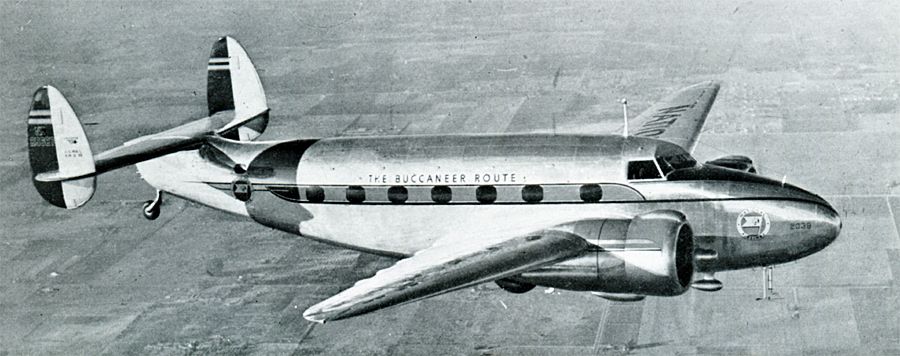 |
|
Lockheed Model 18 Lodestar Introduction The Lockheed Model 18 Lodestar had a fascination for me from the earliest days of my interest in aviation. The picture in the book 86 Flugzeugtypen (86 Types of Aircraft) [1] I received at about the age of 12 never got out of my mind (see picture 2, right). That picture exuded a sort of mystique for me, that lasts until today. Ernest Gann's description of two ferry flights from USA to Rio de Janeiro describes exactly the atmosphere I affiliate with this aircraft [2]. According to my philosophy behind this website which I will explain in the introduction still in work, I generally will be very resrictive in quoting technical specifications. These can be looked up in the sources I quote in the respective notes section. A typical exception can be found below. The Lodestar Characterized Manufacturer was Lockheed Aircraft Corporation, Burbank, USA. Type designation varies from source to source: Just Lodestar, Model 18 Lodestar, Lockheed 18 (or L-18) Lodestar. There were three protoypes of the Model 18 Lodestar which were modified Model 14 Super Electras, the first of which took for its maiden flight in September 1939. The first production Lodestar still got modifications after further testing. It was delivered to a private owner on March 1940 and had a checkered career with USAAF, RAF etc. [4]. The second production Lodestar finally entered service in May 1940 with Mid-Continent Airlines. It will mean opening a can of worms evaluating this early history and list the numerous variants ensuing from various power plants offered. These facts can be looked up in full detail in René Francillon's "Lockheed Aircraft" [3] and Peter Marsons' "Lockheed Twins" [4]. Highly recommended works. Francillon [3] states that "...as most major American carriers were already committed to DC-3 fleets when the type was certificated in March 1940, it attracted only limited commercial orders in the United States.... Fortunately for Lockheed, the Model 18 was far more successful with foreign customers, both airlines and governments" [p.190]. ... Lodestars were also bought new resp. impressed by US militatry forces during the 2nd World War [p191]. Juptner [7] characterizes the Lockheed Lodestar as follows: "Designed primarily for high cruising speeds on the shorter runs, the "18" was especially attractive to smaller airlines, both here and abroad, and equally as versatile in the field of national and international business. ... It was a part workhorse and part racehorse type of airplane. One would think that an airplane of this type would be a fearful beast, but such was not the case; as long as its enthusiasm was guided properly, the "18" was a rather gentle beast and a three-way favorite - it was loved by the pilots, the passengers, and operators alike. There is no doubt that hundreds more of the "Lodestar" could have been sold the world over, but the bolstering up of our national defense had changed the normal outlook for this airplane." Continuing with Francillon [3]: "At the end of the war surplus Lodestars were already obsolescent and did not find favor with major carriers. A few did see service with smaller operators, mostly non-scheduled in the USA and abroad, but the main outlet for these surplus aircraft was the executive and corporate market This potential was further exploited by companies which modified Lodestars to improve their performance and fitted them with special interiors to meet the needs of the most demanding customers." [3,pp.196]. Typical such executive conversions were undertaken by Howard Aero and Lear. For more on Howard's conversions see [W2]. A Howard 250 is shown in picture 4, right. Daivid Stringer [9] states that "National would earn the distinction of beeing the only major airline in the USA never to operate the ubquitous DC-3...[National Airlines president] "... Baker apparantly felt, that the [DC- ] 21-passenger capacity was too big for his needs. Instead he decided to buy Lockheed's ultimate twin-engined airliner, the 14-passenger L-18 Lodestar. Ungainly as [the interior] appeared the Lodestar's advantage was speed. It cruised at 220 mph compared to the DC-3's more stately 170 mph". [8] Natinonal later switched directly to the DC-4. Regarding the service with National Airways Marson [4] points out, that the last remainig Lodestars had been withdrawn from service in 1959. "Thus ended a remarkable 17 years use of the type by what was then one of the trunk carriers of the USA". Bibliography Books, magazines, and websites dealing with the Lockheed Lodestar are included in the Notes section. |
Lockheed L-18 Lodestar Picture 1, above: Lockheed 18 Lodestar. National Airlines. Fuselage bears the advertizing logo "The Buccaneer Route". (Bill Larkins Creative Commons CC BY-SA 2.0) 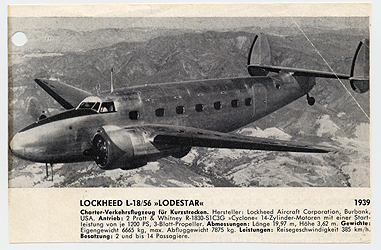 Picture 2: Lockheed 18 Lodestar as seen on page 43 of Fred Anderson's: 86 Flugzeugtypen. [1] 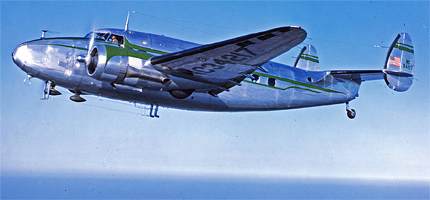 Picture 3: Lockheed 18 Lodestar, James S. Abercrombie Company. Note the tangle of antennae. (Robert Yarnall Richie via DeGolyer Library, SMU [W3]) 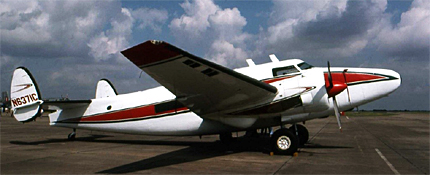 Picture 4 Howard 250 ( Lockheed 18 Lodestar conversion) N6371C , 10/10/1981, Harlingen - Valley International (HRL / KHRL), USA (brian g nichols). 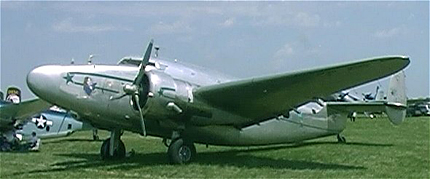 Picture 5: Lockheed 18 Lodestar N1940S c/n 2509 [W 1]. Capture from a video I shot at Air Venture Oshkosh on 28. July 1999. Was for sale. Another view is here. This Lodestar has been provided with an the elongated nose. This spoils the elegnat line of the original Lodestar as to my taste. Much more than with the Howard 250 in the picture above. That fits more harmonic in the look-and-feel of the extensive modifiations. (CJK Collection) |
| back to Contents |
| Home | Aircraft | Various Topics | Books and Magazines | Updates | Contact |
| Started: 02 / 2017 | Revised: | © |